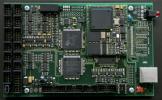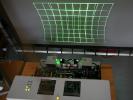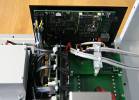ScanMaster3 - Board Revision 2
Laser projector control board, successor of the award-winning ScanMaster2. The board is an
easy-to-use embedded system for controlling an entire laser projection system. It lets client
computers stream data with standard ethernet and TCP/IP instead of using analog signals
with bulky and lossy cable connections. The use of standard computer interfaces further
eliminates the need for special hardware to be used with the signal source. For standalone
operation, the board offers media playback from memory and user interaction through input
devices connected to DMX512, MIDI or application specific interfaces.
The board can be mounted directly into the projector, be run in a standalone adapter box or be
used in recording and playback systems. Project specific hardware and software can be added
easily for applications with special features such as recorders, measurement systems or
industrially used projectors.
Revision 2 major enhancements
Two analog X/Y/Color ports and two digital X/Y/Color ports with device ready
monitoring for galvos and lasers.
Ready for dual-head operation. Two independent, simultaneous working engines for
vector graphics with a throughput of 200k samples/second each.
All converters are connected serially and can be driven with individual timings to allow
precise time shifts, unimpeded by bus traffic.
Color line tweaking provides adjustable command timing offsets between color lines to
match the timing of different solid state laser technologies.
Advanced operation and safety scheme with inputs for enable and standby as well as
outputs for lock release, activity, visibility and exception, implemented in hardware.
CRC protected firmware bundle, integrity checks with every startup. Firmware update
mechanism across networks with a platform independent tool written in Java.
Individual connectors for each device to improve projector wiring. Each laser and each
galvo driver has its own cable and its own connector.



The board comes with outputs and inputs for positioning and monitoring of up to 4
galvanometer scanners, outputs for 8 color channels, power monitoring and device failure
monitoring. For projection system control a fully implemented RS232 port, an I2C bus and
various user I/O signals have been provided. Two dedicated RS232 ports can be used for
user console dialog (same dialog can be held with telnet) and diagnostic messages.
ScanMaster3 can run user software. The firmware bundle is a zip archive containing
software for the base system and the standard ScanMaster3 features. A fully working
default system. Additional firmware, drivers, code for projector feature support like
temperature or voltage monitoring as well as user application code can be added to the
archive and be run by the system. This eliminates the need for further CPUs in the
projection system.
The system supports StageNet's SDCP/SMXP protocols over ethernet and TCP, UDP, IP. See
StageNet.org for more information. All ScanMaster3 interfaces can be accessed with the
protocols and any client can open sessions and exchange data with the unit. For
management a reliable TCP stream is used, for realtime data either UDP or TCP can be used.
Supplemental software features are available separately, as part of a projector support package or
as part of the contractor support program.
System Features
Two analog X/Y/Color ports and two digital X/Y/Color ports with device ready
monitoring for galvos and lasers. One digital high-speed link with interrupt capability
and ready monitoring for application specific use.
Ready for dual-head operation. Two independent, simultaneous working engines for
vector graphics with a throughput of 200k samples/second each. Every sample contains
position, color and control information.
Flexible sample routing concept. Graphics engine outputs can be routed to individual
analog and digital output ports in basic (2 galvo and 4 color channels) and wide (4
galvo and 8 color channels) configurations.
Capable of managing multiple output windows on each scanhead. Every window can
receive its own data and frame rate. Multiple clients can connect to the unit and
exchange data with their windows. The scanhead output is synchronized transparenty.
Realtime interpolation of curves and vectors. This includes color morphing (different
start and end colors for lines) and soft blanking (either start or end color is black).
Support of multiple color spaces and color transformations.
Geometry processor with choice of multiple sets of algorithms and parameterizations. Corrections
include pincushion, keystone, barrel, linearity, skew and bow. Transformations of X/Y for use of 4 galvos in wide port mode and
3D mappings.
Laser power linearisation, individually for all color lines. Uses an interpolated 8 Bit to
10 Bit map to adjust non-linear laser power response of solid state lasers.
Supports timeshifts for galvo monitor (based on galvo command), color and blanking
(based on galvo command, known as colorshift), power monitor (based on blanking) and
color lines (based on blanking, introduced as color line tweaking).
Timeshifts between signal outputs are parameterized in units of microseconds with a
resolution of 125 nanoseconds. This keeps the configured shift stable for all sample
frequencies.
Color line tweaking provides adjustable command timing offsets between color lines to
match the timing of different solid state laser technologies. Each laser can be
configured in its response to the command.
System status monitor. Provides informations like current frame rate, ready line status
or device failure. Additional information like projector temperature or voltage
measurement can be added through projector firmware.
Operation parameter exchange. This system interface lets clients modify configuration,
view status information and execute remote procedure calls through various protocols
including console dialog, StageNet.org and http.
Frame rate limiter with acceleration and laser power compensated lead-in and lead-out
calculations for invisible operation to address safety issues with short scan paths.
Dimmer ramp to seamlessly match laser power between frames with long and short
scan paths. Short paths can be adjusted to reduce power and appear darker. The ramp
equalizes visible brightness between frames in show content.
Advanced operation and safety scheme with inputs for enable (used with interlock
loops or emergency stop) and standby (used with keyswitches) as well as outputs for
lock release (up and running indicator), output stream activity (used for visible output
indicators), color port visibility (each color port, used to open shutters) and exception
(general malfunction), implemented in hardware.
Device ready and global enable signals control all safety relevant precautions. The path
is wired in hardware and monitored by the CPU. It is used for immediate revocation of
validity (digital blanking), suppression of color commands and revocation of visibility
(shutter). The monitoring software in turn commands the suspension of the projection
engine with an inherent revocation of the visible output indicator.
Safe hardware and software implementation with validity checks and monitoring to
avoid erratic behaviour. Output deactivation in case of malfunction.
CRC protected firmware bundle, integrity checks with every startup. Firmware update
mechanism across networks with a platform independent tool written in Java.
Optional Features
Builtin http server for configuration using web-browsers.
Filesystem for CF-Cards (FAT16), read and write support.
Protocols for digital galvo driver communication.
Recording of analog laser shows from existing systems.
Monitoring and analysis of galvo command and feedback signals.
Additional graphics engines for use of all digital and analog ports simultaneously.
Hardware Features: PowerPC Subsystem
10/100MBit twisted pair ethernet with autonegotiation and 7 LEDs for detailed link
status display. Choice of using an onboard RJ45 socket or header for internal wiring.
RS232 console dialog interface and telnet daemon for setup and configuration dialogs
with standard terminal software and telnet clients. Additional RS232 interface for
diagnostic messages.
Fully implemented asynchronous serial port for use with other external devices
including modems or lasers. Alternatively all signals can be used as GPIOs. Level
converters must be attached externally in case the port is used as an RS232 interface.
I2C System expansion bus for communication inside the projector. Intended for PIO
circuits, configuration memory, voltage measurements, temperature control and such.
IrDA port. Physical layer must be attached externally.
2 CAN ports including physical layer.
FPGA for I/O and interface protocol assistance. Provides 42 signals to be used as GPIOs
or with protocols, including a dedicated port for LCD-Display communication.
DMX512 inout and output implemented in the FPGA. Buffered frame and fifo stream
mode available for transmission, fifo stream mode available for reception. Precise
timing and flexible break handling.
Up to 10 partially interrupt capable PowerPC GPIO signals.
16 KByte serial EEPROM for system configuration.
Low power clock circuitry with capacitor and battery backup. The capacitor can keep
the RTC running for about two weeks. The battery will be used thereafter. The device
has a unique 64 bit ROM ID.
CompactFlash Port for use with CF Type I and Type II cards.
Diagnostic LEDs for run status, exception and error code.
133 MHz system clock, 256 MByte SDRAM and 32 MByte flash ROM system memory.
Hardware Features: DSP Subsystem
2x16 Bit dual DAC for (X1, Y1) and (X2, Y2) commands.
4x14 Bit ADC for X1, Y1, X2, Y2 position feedback.
8x10 Bit DAC for color lines, brush, intensity and such.
2x14 Bit ADC for beampower measurements.
All converters are connected serially and can be driven with individual timings to allow
precise time shifts, unimpeded by bus traffic.
16 digital inputs for ready monitoring of external devices.
Analog signals are grouped in two X/Y/color ports, driven independently in basic mode
or linked together with the same timebase in wide mode. Basic mode provides 4 color
lines per port, wide mode provides 8 color lines.
Fully implemented ISP output (An adapter board, piggyback or DB25-PCB, must be
used for balancing and isolation).
Fully implemented ISP input (a piggyback adapter board must be used for isolation
and sampling). The input can be used for easier migration of existing analog systems or
recording applications.
FPGA for timing, routing, ready monitoring, converter protocol assistence and digital
links to external devices.
Powerful 160 MHz DSP with 256 KByte of 0-wait high speed RAM.
Hardware Features: Board
3-CPU system with a total processing power of approx. 470 MIPS.
High-speed parallel and serial data links between processor subsystems.
Jumper free and fanless operation.
Single +5V power supply.
Clean and stabilized power supplies for all analog circuitry.
100x160mm form factor, 4 layer board, single side mounted, height: 20mm (4HP).
The ease of use, the scalability through networking, its rich feature set and versatility, its
numerous interfaces, its powerful vector engine, local optimizations and monitoring, the
ability to run application specific software, its large computing power while being fanless
and its small size make this board unique in the whole laser industry.
Unlike most other systems ScanMaster3 does point calulation on the fly. Frames arriving from
the network are transformed according to the settings of their associated window and
color space conversion is done. Ordinary point data is passed through the pipeline while
interpolation runs over lines and curves and calculates color morphing and line styles with
the galvo's maximum step increment.
For vector data an optimizer takes care of sharp edges and maximum galvo velocity through
variable timing calculation amd vertex resampling. The rest of the pipeline is power
processing, savety zone control, geometry correction, power linearisation, time shifts, galvo
command output and galvo safety monitoring.
The ability to process the rendering of lines and curves in realtime puts new freedom into
the hands of show designes. Instead of doing the dot monkey, being able to use convenient
strokes and let ScanMaster do the timing.
|




